Business
Cadence Design Systems Faces Challenges Amid AI Demand and Geopolitical Risks

FREMONT, California — Investors are watching closely as Cadence Design Systems navigates a challenging economic environment. The company, known for its electronic design automation (EDA) tools, is facing geopolitical risks, particularly related to its exposure to China.
A recent analysis indicates that while Cadence is well-positioned to leverage AI-driven innovations in its market, its long-term success may hinge on the global economic climate. Analysts suggest that sustaining demand for Cadence’s products, especially in light of growing competition in design automation software, will be crucial.
The integration of Murata’s component libraries into Cadence’s EDA platforms aims to solidify its market position, but experts warn that this collaboration alone may not significantly impact Cadence’s immediate financial performance. The company has projected $6.9 billion in revenue and $1.7 billion in earnings by 2028, reflecting a 10.9% annual growth rate.
Recent developments show a rising interest in Cadence’s Reality Digital Twin Platform, especially after its September 9 expansion that incorporated technology from NVIDIA. This partnership highlights the ongoing demand from data center and AI clients.
However, analysts highlight that potential volatility from tariffs and geopolitical tensions could disrupt Cadence’s customer base. With shares showing volatility over the past year, including a 5.4% drop related to renewed trade war fears, the company’s stock performance remains under scrutiny.
As of the latest estimates, Cadence’s stock is trading at $345.26, close to its 52-week high of $373.37. Investors who purchased shares five years ago have seen their investment increase significantly, indicating strong historical growth. While Cadence shows promise, the broader market conditions will likely play a critical role in shaping its future.












